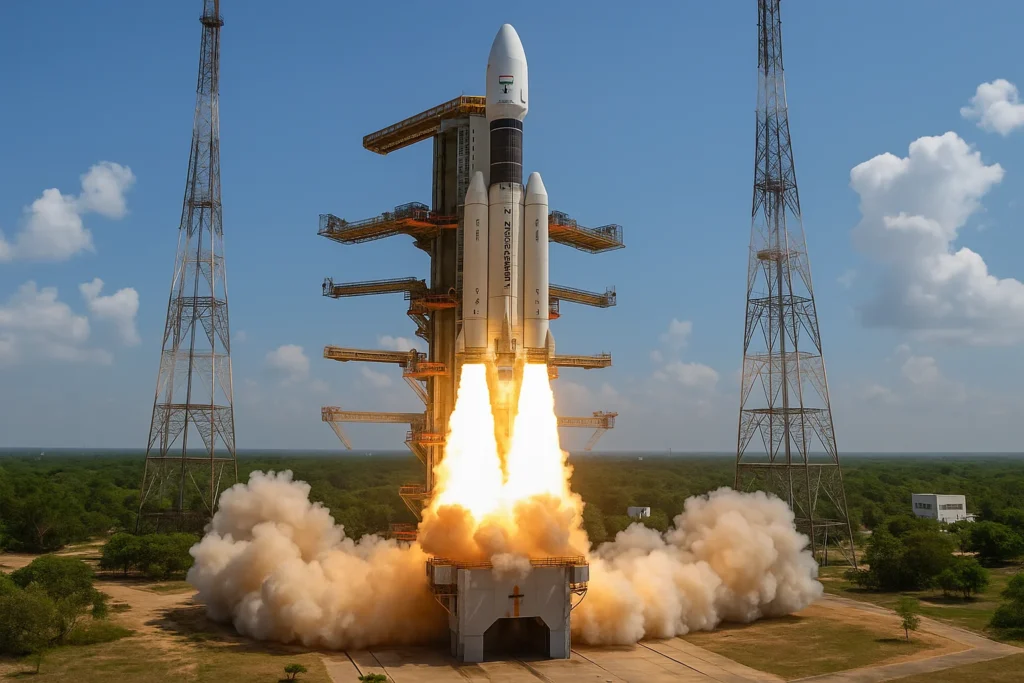The dawn over the Satish Dhawan Space Centre in Sriharikota was broken not by the gentle lapping of waves, but by a deafening roar that shook the very ground. On this pivotal morning, the GSLV Mark III, India’s most powerful rocket, lifted off the launchpad, its fiery tail a beacon of national ambition. It wasn’t merely carrying a payload into space; it was launching the hopes of a billion people and embarking on the most audacious lunar mission in India’s history: Chandrayaan-4. This mission’s primary objective was unprecedented for the Indian Space Research Organisation (ISRO): to land on the Moon’s rugged south pole, collect samples of lunar soil and rocks, and successfully return them to Earth.
Success would not only place India in an exclusive club of spacefaring nations—alongside the United States, Russia, and China—but would also be a colossal scientific triumph. Chandrayaan-4 is not a mere repeat of past missions; it is a quest to unravel cosmic mysteries locked within ancient rocks, potentially rewriting our understanding of the early solar system’s tumultuous history. The data and samples brought back could be a treasure trove, providing answers to questions that have puzzled scientists for decades.
The Grand Vision: Why Chandrayaan-4 is a Game-Changer
1. India’s First Lunar Sample-Return Mission
Previous Chandrayaan missions served as vital stepping stones. Chandrayaan-1’s orbiter provided the first definitive evidence of water molecules on the Moon, a discovery that fundamentally changed lunar science. Chandrayaan-2’s orbiter generated high-resolution maps of the lunar surface. Chandrayaan-3 achieved a historic soft landing, demonstrating India’s capability to master complex lunar navigation. Chandrayaan-4, however, represents a quantum leap in technological sophistication. The mission’s goal is to go beyond observation and in-situ analysis. It involves a series of intricate, interdependent phases: a pinpoint-accurate landing in a hostile environment, the deployment of a robotic system to collect a minimum of 500 grams of lunar material, and the safe return of these samples in a dedicated capsule. This requires a level of autonomy and precision that few nations have ever achieved. The success of this mission would signal India’s arrival as a leader in end-to-end space exploration capabilities.
2. Targeting the Enigmatic South Pole
The Moon’s south pole is an area of intense scientific fascination and strategic importance. Unlike the well-trodden equatorial regions, which have been explored by missions like Apollo, the south pole is a landscape of extremes. Its unique axial tilt means that certain deep craters are permanently shadowed, their interiors shielded from sunlight for billions of years. Within these “cold traps,” temperatures plummet to a frigid -200°C. Scientists believe these areas are a high-probability site for vast deposits of water ice. This water ice could be a transformative resource, providing future lunar colonists with drinking water, breathable air (by splitting the water molecules), and even rocket fuel. Additionally, the rocks and soil in these ancient, undisturbed regions are believed to contain a geological time capsule, preserving a record of the early solar system. By studying these pristine samples, scientists can glean insights into the Moon’s violent formation, the history of asteroid impacts, and the evolution of our planetary neighborhood.
3. A Testament to Global Collaboration
Space exploration has evolved from a competitive race into a collaborative endeavor, and Chandrayaan-4 is a shining example of this new paradigm. ISRO has forged meaningful partnerships with leading international agencies, including France’s CNES, the Japan Aerospace Exploration Agency (JAXA), and the European Space Agency (ESA). This collaboration goes beyond mere data sharing; it involves the co-development and integration of advanced scientific instruments. For instance, sensors and spectrometers from these partner nations are part of the Chandrayaan-4 payload, enhancing the mission’s scientific return. This shared-knowledge approach accelerates discovery and demonstrates that humanity’s greatest scientific challenges are best tackled together.
The Mission’s Intricate Blueprint
1. The Launch and Lunar Transit
The Chandrayaan-4 mission began its journey atop the GSLV Mark III, a rocket specifically designed to carry heavy payloads to deep space. The spacecraft, a complex assembly of modules, was injected into a precise transfer orbit, beginning a five-day voyage to the Moon. This rapid transit was made possible by the powerful rocket and a series of meticulously planned orbital maneuvers. Once in lunar orbit, the spacecraft will spend several weeks performing intricate braking burns to lower its altitude and prepare for the final descent. The landing site, a pre-selected spot within the challenging south polar terrain, was chosen after extensive analysis of data from previous missions.
2. The Lander and Pragyan-2 Rover
The core of the mission is the landing module, which houses the Pragyan-2 rover. This upgraded rover is a more robust and sophisticated version of its predecessor, equipped with a new suite of instruments. Its primary role is to explore the immediate vicinity of the landing site, analyzing soil composition and searching for evidence of water ice. A robotic arm on the lander itself will perform the crucial task of collecting the samples. The arm, with its specialized scoop and drilling mechanism, is designed to operate in the extreme cold and harsh conditions of the south pole. The collected samples will then be hermetically sealed within a specially designed canister to prevent contamination from Earth’s atmosphere.
3. The Return Journey: Bringing the Moon Home
Once the samples are secured, a small ascent module will launch from the lander, carrying the precious canister into lunar orbit. This module will then perform a delicate and highly autonomous orbital rendezvous and docking with the main orbiter. The sample canister will be transferred into a dedicated Earth re-entry capsule. This capsule is engineered to withstand the monumental stress of atmospheric re-entry. It will be traveling at over 11 kilometers per second and must endure immense heat and friction. After a fiery descent, the capsule will deploy parachutes for a gentle splashdown in the Indian Ocean, where it will be recovered by ISRO teams by December 2025.
The Scientific Payoff: Unlocking Cosmic Secrets
1. Confirming and Characterizing Lunar Water
The biggest question Chandrayaan-4 seeks to answer is the definitive nature of water ice at the south pole. While previous missions have provided strong indirect evidence, Chandrayaan-4 will provide direct physical proof through its in-situ analysis and the return of samples. This mission will not only confirm its presence but also help characterize its composition, quantity, and distribution. A verified resource of lunar water would be a monumental discovery, not just for science but for the future of human spaceflight. It would make the vision of a permanent lunar base a more plausible reality, as water could be used for life support and as a source of fuel.
2. Analyzing the Most Ancient Lunar Rocks
The south pole’s cold traps have preserved rocks that may be far older than any samples ever collected. The Apollo missions brought back samples from the equatorial regions, which told a specific story. The Chandrayaan-4 samples, by contrast, could provide a missing chapter in lunar history. Scientists hope to use these rocks to:
- Refine the Giant-Impact Hypothesis, which posits that the Moon formed from a collision between Earth and a protoplanet.
- Gain a clearer understanding of the Late Heavy Bombardment, a period when the early solar system was barraged by asteroids and comets.
- Search for evidence of early volcanic or magnetic activity on the Moon that might have been erased elsewhere.
3. Paving the Way for Future Human Missions
Beyond the scientific discoveries, Chandrayaan-4 is a critical preparatory mission for India’s future human spaceflight ambitions. ISRO is targeting a crewed lunar mission by 2040. The data collected from Chandrayaan-4 will be invaluable for planning such an expedition. It will provide crucial information on the south pole’s terrain, radiation levels, and resource availability—all of which are essential for designing safe and sustainable human habitats. By mastering the technology for robotic sample return, India is building the foundation for a future where its astronauts can safely explore and work on the Moon.
Challenges and Global Implications
1. Technical Hurdles
The journey of Chandrayaan-4 is fraught with formidable challenges. The precision landing in the south pole’s darkness is a high-stakes maneuver, requiring an autonomous system capable of navigating a terrain full of craters and boulders. The sample collection process itself is a technical marvel, as it must be performed in extreme cold without contaminating the samples. Finally, the safe re-entry of the capsule, a fiery plunge through Earth’s atmosphere, leaves no room for error. A single flaw could see the invaluable samples destroyed.
2. India’s Position in the Global Space Race
A successful Chandrayaan-4 mission would solidify India’s status as a formidable space power, capable of complex, multi-faceted missions. It would open doors for more ambitious projects, such as a Mars sample-return mission or a deep-space probe to Venus. The mission also reinforces the idea that space exploration is a global endeavor, with India at the forefront of fostering international partnerships. The collaboration with agencies like ESA and JAXA is a powerful symbol of this new era of cooperation.
3. The Legacy of Inspiration
Chandrayaan-4 is more than a technical achievement; it is a source of national pride and a powerful tool for inspiration. Just as the Apollo program inspired a generation of scientists and engineers in the West, Chandrayaan-4 is fueling interest in STEM fields across India. It shows young people that dreams of space exploration are not just for Hollywood movies but are achievable through hard work and ingenuity. The mission’s success would be a beacon of hope, inspiring a new generation to reach for the stars.
Conclusion: A Giant Leap for India and All of Humanity
Chandrayaan-4 is a symbol of India’s unwavering commitment to scientific discovery and technological innovation. It represents the culmination of decades of hard work, perseverance, and a bold vision for the future. If all goes well, by the end of 2025, a small capsule will be recovered from the Indian Ocean, carrying with it a piece of the Moon’s oldest secrets. These pristine rocks have the potential to unlock mysteries that have been hidden for billions of years, providing a new perspective on our cosmic origins. This mission proves that space exploration is a shared human endeavor, a collective push to expand the boundaries of knowledge and inspire the next generation to look up at the night sky and dream big.



